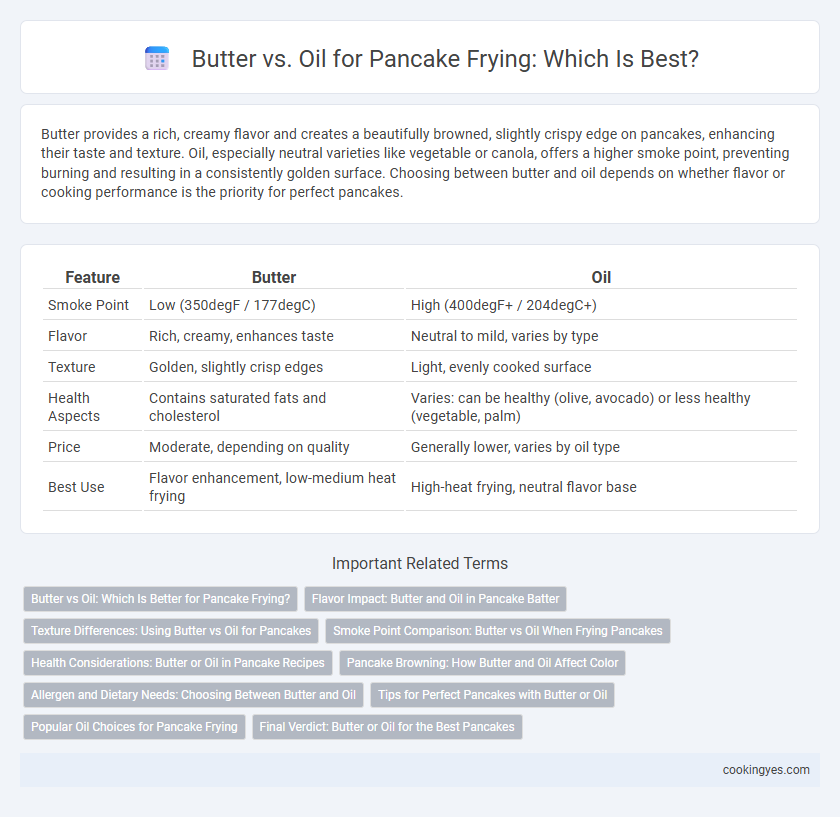Butter provides a rich, creamy flavor and creates a beautifully browned, slightly crispy edge on pancakes, enhancing their taste and texture. Oil, especially neutral varieties like vegetable or canola, offers a higher smoke point, preventing burning and resulting in a consistently golden surface. Choosing between butter and oil depends on whether flavor or cooking performance is the priority for perfect pancakes.
Table of Comparison
| Feature | Butter | Oil |
|---|---|---|
| Smoke Point | Low (350degF / 177degC) | High (400degF+ / 204degC+) |
| Flavor | Rich, creamy, enhances taste | Neutral to mild, varies by type |
| Texture | Golden, slightly crisp edges | Light, evenly cooked surface |
| Health Aspects | Contains saturated fats and cholesterol | Varies: can be healthy (olive, avocado) or less healthy (vegetable, palm) |
| Price | Moderate, depending on quality | Generally lower, varies by oil type |
| Best Use | Flavor enhancement, low-medium heat frying | High-heat frying, neutral flavor base |
Butter vs Oil: Which Is Better for Pancake Frying?
Butter provides a rich, creamy flavor and can create a slightly crispy edge on pancakes due to its milk solids browning during frying. Oil, especially neutral options like vegetable or canola oil, offers a higher smoke point and a lighter texture without altering the pancake's taste. For optimal pancake frying, choosing butter enhances flavor while oil ensures better heat tolerance and less risk of burning.
Flavor Impact: Butter and Oil in Pancake Batter
Butter enhances pancake batter with a rich, creamy flavor and a slightly nutty aroma that oil cannot replicate, creating a more indulgent taste experience. Oil, typically neutral in flavor, allows the natural taste of the pancake ingredients to shine without adding extra richness. Choosing butter over oil in pancake frying significantly influences the final flavor profile, making pancakes more flavorful and aromatic.
Texture Differences: Using Butter vs Oil for Pancakes
Butter creates a rich, golden-brown crust on pancakes with a slightly crispy edge and a tender, moist interior due to its water and milk solids content. Oil, being pure fat, results in a smoother surface and more evenly cooked pancakes with a soft and fluffy texture but less crispiness. The choice between butter and oil impacts the overall pancake mouthfeel, with butter offering a more complex texture contrast while oil provides a consistently soft bite.
Smoke Point Comparison: Butter vs Oil When Frying Pancakes
Butter has a lower smoke point, typically around 350degF (177degC), which can cause it to burn quickly when frying pancakes, resulting in a bitter flavor and uneven cooking. In contrast, oils like canola or vegetable oil have higher smoke points, ranging from 400degF to 450degF (204degC to 232degC), allowing for more consistent heat and golden-brown pancakes without smoking or burning. Choosing oil over butter for frying pancakes helps achieve a better texture and taste due to its ability to withstand higher cooking temperatures.
Health Considerations: Butter or Oil in Pancake Recipes
Butter contains saturated fats and provides a rich flavor but may contribute to higher cholesterol levels when consumed excessively. Oils like olive or canola offer healthier unsaturated fats that support heart health and reduce inflammation. Choosing oil over butter for pancake frying can enhance nutritional value without sacrificing moisture or texture.
Pancake Browning: How Butter and Oil Affect Color
Butter contains milk solids that caramelize during frying, producing a rich, golden-brown crust on pancakes due to the Maillard reaction. Oil, lacking these milk solids, tends to promote even browning but results in a lighter, less flavorful color. The choice between butter and oil directly influences pancake browning intensity and the development of complex flavors on the surface.
Allergen and Dietary Needs: Choosing Between Butter and Oil
Butter contains dairy proteins that may trigger allergies and is unsuitable for lactose-intolerant or vegan individuals, while oils such as coconut, olive, or sunflower are plant-based and hypoallergenic options. Oil often aligns better with vegan and dairy-free diets and provides a neutral or specific flavor profile depending on the type used. Selecting oil or butter impacts allergen exposure and dietary compliance, making oil preferable for allergen-sensitive or specialized dietary needs in pancake frying.
Tips for Perfect Pancakes with Butter or Oil
For perfect pancakes, using butter adds rich flavor and creates a golden, crispy edge, while oil ensures even heating and prevents sticking without burning quickly. Choose clarified butter to reduce smoke and maintain the buttery taste, or use neutral oils like vegetable or canola oil for a light, consistent cook. Maintaining medium heat and lightly greasing the pan between batches ensures fluffy, evenly cooked pancakes with either fat.
Popular Oil Choices for Pancake Frying
Popular oil choices for pancake frying include vegetable oil, canola oil, and coconut oil, valued for their high smoke points and neutral flavors that enhance texture without overpowering taste. Butter imparts a rich, creamy flavor and golden color, but it has a lower smoke point, which can cause burning during cooking. Using oils like canola or vegetable oil ensures even browning and crisp edges, making them preferred options for achieving perfect pancakes.
Final Verdict: Butter or Oil for the Best Pancakes
Butter imparts a rich, creamy flavor and creates a golden, crispy edge on pancakes, enhancing taste and texture. Oil, especially neutral options like canola or vegetable oil, provides a higher smoke point, preventing burning and ensuring even cooking. For the best pancakes, combining both can harness butter's flavor and oil's heat tolerance for optimal results.
Butter vs oil for pancake frying Infographic

 cookingyes.com
cookingyes.com